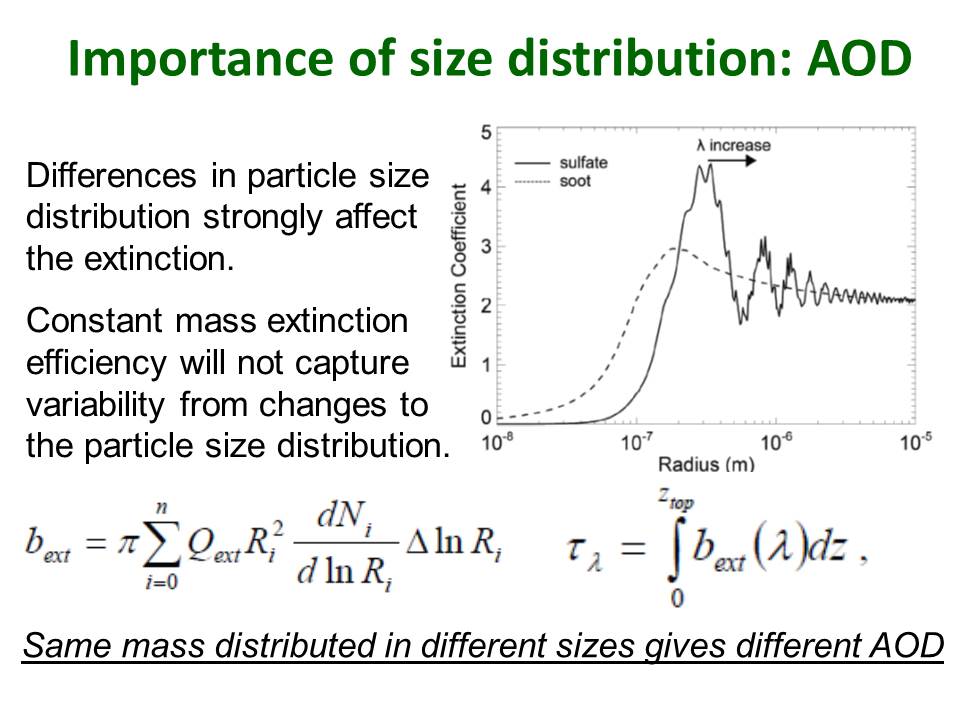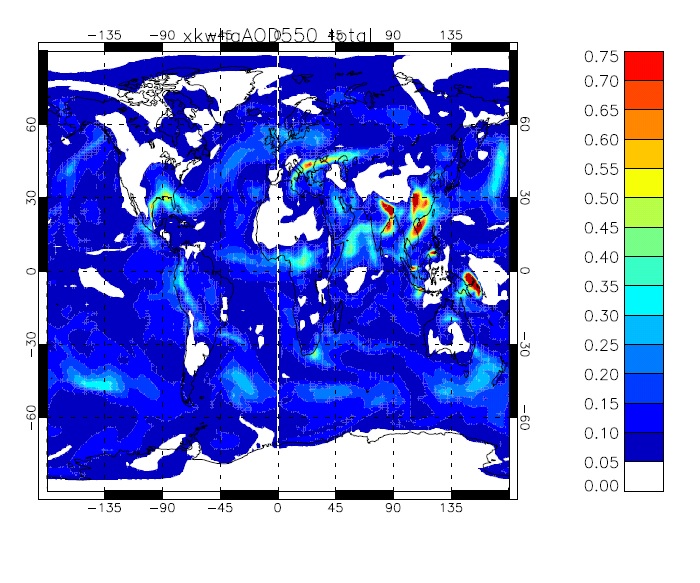UKCA Chemistry and Aerosol Tutorial 10
Back to UKCA Chemistry and Aerosol Tutorials
What you will learn in this Tutorial
In this tutorial you will learn about the Aerosol Optical Depth and how aerosol optical properties are diagnosed by RADAER GLOMAP-mode aerosol module and how it tracks different aerosol types within several size classes.
Task 10.1: What is the aerosol optical depth?
Aerosol particles affect the Earth's radiative balance by scattering and absorbing solar radiation and, where they are large enough, can also act similarly to a greenhouse gas by absorbing outgoing terrestrial long-wave radiation.
The aerosol optical depth (AOD), sometimes referred to as aerosol optical thickness (AOT), is often used in atmospheric science to indicate the overall strength of aerosol-radiation interactions at a particular wavelength.
The AOD is defined as the vertical integral of the monochromatic (single-wavelength) extinction (the sum of scattering plus absorption) through the atmospheric column. It is common also to refer to an absorption AOD which represents the integral of just the single-wavelength absorption.
The Unified Model (UM) radiation scheme divides the shortwave and longwave spectra into wavebands. To enable UKCA simulated gases or aerosols to interact with the UM radiation scheme, their optical properties need to be integrated across each of these wavebands. For aerosols, the radiation scheme requires the specific scattering and absorption coefficients, which describe the strength of aerosol scattering and absorption processes per unit aerosol mass (in m kg), and the asymmetry parameter, which describes in a simplified way the angular dependence of the scattering (dimensionless). The specific scattering and absorption coefficients, and the asymmetry parameter, are hereafter referred to as the aerosol optical properties.
Task 10.2: Understand the principles behind GLOMAP and how aerosol optical properties are derived via RADAER
Mie theory describes the scattering and absorption of light by spherical particles. Essentially, the scattering/absorption efficiency can be parameterized in terms of two parameters: the (complex) refractive index of the particle and the Mie parameter, which describes the particle size dependence in relation to the wavelength of light under consideration.
The Figure in the slide below shows the dependence on particle size of the extinction efficiency for mid-visible (550nm, green) light for two different types of particle (refractive index).
The aerosol scheme used for UK climate model simulations in CMIP5 was called the Coupled Large‐scale Aerosol Simulator for Studies In Climate (CLASSIC). CLASSIC is a simpler scheme than the microphysical GLOMAP scheme included in UKCA but has a comprehensive representation of the main aerosol sources, tracking up to eight tropospheric aerosol species: ammonium sulphate, mineral dust, sea salt, fossil fuel black carbon, fossil fuel organic carbon, biomass burning aerosols, secondary organic (also called biogenic), and ammonium nitrate aerosols.
However, the size distribution and refractive index for each of the CLASSIC transported aerosol types was prescribed to have globally and temporally uniform values. Some variation in aerosol properties was resolved by having fresh and aged sub-types for each aerosol type, which then allow size and refractive index to vary from values near-source (fresh) to remote (aged).
With this approach, optical properties for each of the CLASSIC aerosol types is derived based on Mie calculations using the prescribed size distributions and refractive indices for each of the transported aerosol masses and assuming hygroscopic growth factors for the water associated with each.
The GLOMAP-mode aerosol scheme in UKCA simulates the evolution of size-resolved aerosol properties, including microphysical processes such as new particle formation, coagulation, condensation (gas-to-particle-transfer) and cloud processing.
Whereas CLASSIC simulated only the mass of several aerosol types, the transported tracers in GLOMAP are particle number and mass in different size classes spanning the particle size range from 3nm up to around 20 microns dry diameter.
Processes such as condensation and aqueous sulphate production grow particles by increasing the mass in a size class while conserving particle number.
As was as microphysical processes, GLOMAP also includes size-resolved representations of primary emissions (e.g. sea-salt, dust and carbonaceous particles) and of removal processes including particle dry deposition, sedimentation, nucleation scavenging (rainout) and impaction scavenging (washout).
GLOMAP therefore simulates the evolution of particle composition across the size spectrum over several different components as determined by the aerosol processes included.
The original version of GLOMAP (known as GLOMAP-bin) uses a two-moment sectional aerosol dynamics approach, with typically 20 bins spanning the size spectrum, but when tracking several aerosol types, becomes too expensive for running multi-decadal integrations as required in a climate model. For UKCA, a new computationally cheaper version of GLOMAP was developed (GLOMAP-mode), which has the same process representations, but using log-normal modes as its size classes. Each size mode in GLOMAP-mode covers one of four size ranges, with additional separation among soluble and insoluble modes.
GLOMAP has been developed to follow a flexible multi-component approach, with the same code able to be run with different levels of composition/size sophistication with FORTRAN-90 modules providing alternative aerosol mode set-up arrays. The GLOMAP-mode aerosol scheme in UKCA not only simulates the dry aerosol mass, but also the mass of water attached to the aerosol, and the aerosol number concentrations.
The calculation of aerosol optical properties from GLOMAP is carried out via the RADAER module within UKCA.
Compared to CLASSIC, the GLOMAP-mode scheme introduces three important changes which are relevant for simulated aerosol-radiation interactions:
A) The mean radius of each size class (mode) varies in time and space as determined by transport and aerosol processes.
B) There is a refractive index for each size class (mode) which varies according to its internally-mixed composition.
C) The amount of aerosol water in each soluble mode varies interactively consistent with its composition.
RADAER relies on pre-computed look-up tables of monochromatic optical properties, covering all realistic combinations of modal radii and refractive indices. At runtime, remaining tasks are:
A) to compute the modal refractive index out of the simulated chemical composition of each mode.
B) to obtain the monochromatic properties from the look-up tables at selected wavelengths within each shortwave and longwave waveband.
C) to integrate across each waveband to obtain the waveband-averaged optical properties, which can be used by the radiation code.
As well as providing the waveband-averaged scattering, extinction and asymetry parameters from GLOMAP, RADAER also diagnoses monochromatic Aerosol Optical Depth (AOD) for each of the GLOMAP modes.
Task 10.3: Output daily-mean Aerosol Optical Depths from your UKCA model run
In this task you will update your copy of the UKCA tutorial job (xkvxe) adding extra STASH requests to output daily-mean AODs from GLOMAP.
UM-UKCA diagnoses the AOD from each of the GLOMAP modes as a separate STASH item.
All of the GLOMAP AOD diagnostics are contained with STASH section 2 (long-wave radiation) in items numbers near to those used for the AOD diagnostics from CLASSIC.
Section 2 items 300-305 contain the AOD for the Aitken-soluble, accumulation-soluble, coarse-soluble, Aitken-insoluble, accumulation-insoluble and coarse-soluble modes respectively.
The dimensions for each of these STASH items is 2D global in longitude and latitude but there is also a third dimension containing 6 pseudo levels for the 6 monochromatic AODs stored by the model (at 0.38, 0.44, 0.55, 0.67, 0.87, 1.02 micron wavelengths).
Note that there is no nucleation mode AOD as those particles are too small to significantly scatter or absorb radiation at these wavelenghts.
Diagnostics for the absorption AOD in these 6 modes can be requested via STASH section 2 items 240 to 245.
There are also separate "stratospheric AOD" diagnostics in section 2 items 254 to 259 which can also be requested to store the AOD in levels above the tropopause.
To output AODs from GLOMAP, you need to add in some extra STASH requests for the section 2 items 300 to 305.
To output as a daily-mean select the usage profile "UPA" to output to the .pa files and the time profile "TDAYM" for daily-means. For AOD STASH requests, you need to select the domain profile DIAG_AOT to output over the longitude, latitude and 6 wavelength pseudo-levels.
As an example I have put below a jpeg showing a global map of the daily-mean AOD at 550nm (total over all modes) for 1st December 1999 from the UKCA tutorial job (gmann job xkwhg).
In preparation for the next task, you should also try adding daily-mean STASH requests for the OM mass mixing ratios (mmr's) in each mode. Section 34 items 106, 110, 116, 121 and 126 contain the OM mmr's in the Aitken-soluble, accumulation-soluble, coarse-soluble, Aitken-insoluble and nucleation-soluble modes respectively.
Written by Graham Mann 2014



